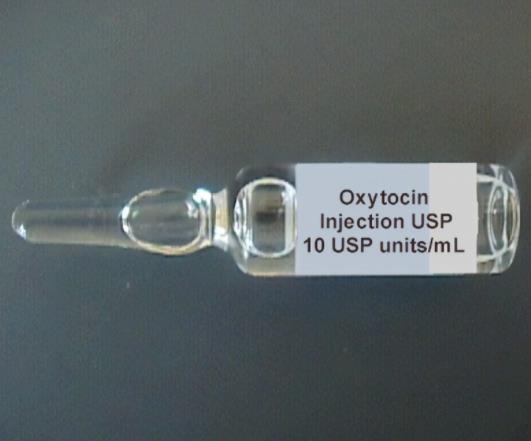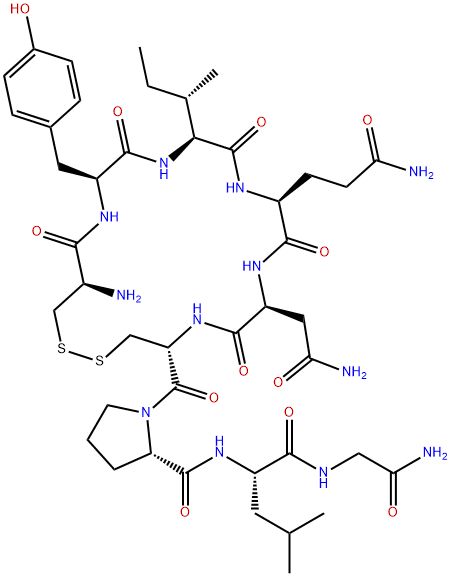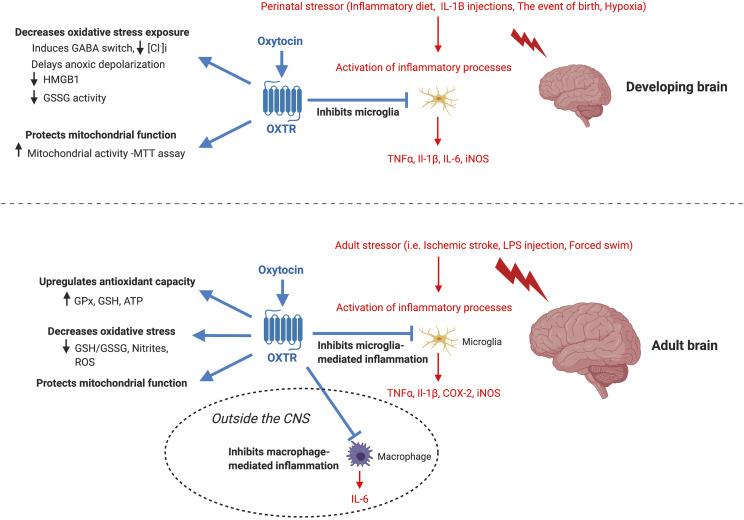Oxytocin:Mechanism, Application, Adverse Effects, Contraindications and Cautions Studies
General Description
Oxytocin is an oligopeptide hormone that contains nine amino acyl residues, or in other words, a nonapeptide hormone. It is one of the two hormones stored.[5]At the same time, as neurohormone in mammals,it is a neuropeptide synthesized in the hypothalamus at the paraventricular nucleus and supraoptic nucleus,form the hypothalamo-neuro-hypophysial system alongside with arginine vasopressin and responsible for approach behavior, cognition, reading emotions, engaging with peers, social processing, social anxiety, and fear. Historically considered as a pro-social hormone, today oxytocin promotes both positive and negative social interactions within context.[1,4]Oxytocin has a potent contractile activity on the pregnant uterus.[2] Its the principal functions of which are to stimulate contractions of the uterus during labour, to stimulate the ejection of milk (letdown) during lactation, and to promote maternal nurturing behaviour. Oxytocin is thought to influence a number of other physiological and behavioral processes as well, particularly sexual and social behaviour in males and females. In both sexes, oxytocin is produced by the hypothalamus and stored and secreted into the bloodstream from the posterior pituitary gland. It is also synthesized and secreted in other tissues, including the brain, uterus, placenta, ovaries, and testes.[1]Additionally, Oxytocin activities can be blocked by OXTR agonists, such as atosiban, dnalovt or carbetocin.[1]

Figure 1 Oxytocin Injection
Mechanism
Oxytocin is one of the few that exhibit positive feedback loops, i.e., that the release of oxytocin leads to actions that stimulate even more of a release of oxytocin.Exogenous oxytocin causes the same response in the female reproductive system as that of endogenous oxytocin. Both types of oxytocin stimulate uterine contractions in the myometrium by causing G-protein coupled receptors to stimulate a rise in intracellular calcium in uterine myofibrils. Oxytocin receptor activation causes many signals that stimulate uterine contraction by increasing intracellular calcium levels, which is where positive feedback comes into play. When oxytocin is released, it stimulates uterine contractions, and these uterine contractions, in turn, cause more oxytocin to be released; this is what causes the increase in both the intensity and frequency of contractions and enables a mother to carry out vaginal delivery completely. The head of the fetus pushes against the cervix, the nerve impulses from this action travel to the mother’s brain, which activates the posterior pituitary to secrete oxytocin. This oxytocin is then carried through the blood to the uterus to increase uterine contractions further, and the cycle continues until parturition.[5]
Application
Firstly, the effects on reproductive tissues:In the uterus, oxytocin exerts its effects by binding to oxytocin receptors on smooth-muscle cells. In late pregnancy(at term) and in preterm labour, the number of oxytocin receptors increases, accompanied by a marked increase in the sensitivity of the uterus to oxytocin. During fetal expulsion, the posterior pituitary releases oxytocin in pulses.In women whose labour is prolonged or flagging, injections of oxytocin may be used to facilitate the labour process.In the mammary gland, oxytocin receptors are present on myoepithelial cells, which contract to expel milk from the milk ducts in response to oxytocin binding. Oxytocin receptors are also expressed on tissues of the male reproductive tract, including in the epididymis, penis, prostate, testis, and vas deferens. Although the function of oxytocin binding in those tissues is not fully understood, proposed roles include the facilitation of ejaculation and sperm transport.[1]Secondly, playing a role in pro-social behaviour:Oxytocin and its receptors also play a role in pro-social behaviours, including in social motivation, social recognition, trust, and pair-bonding. In addition, in studies of individuals with autism, oxytocin administered via nasal inhalation was associated with increased attentiveness to facial stimuli and enhanced social aptitude.Oxytocin plays an important role in cognition and behavior, and is thought to be affecting WS(Williams Syndrome.[3]Lastly, oxytocin also has both antidiuretic and vasodilatory effects, increasing cerebral, coronary, and even renal blood flow.[5]
Adverse Effects
Common side effects of oxytocin administration include the following: erythema at the site of injection, intensified contractions, more frequent contractions, nausea, vomiting, stomach pain, and loss of appetite. Serious adverse effects that require monitoring after oxytocin administration include cardiac arrhythmias, seizures, anaphylaxis, confusion, hallucinations, extreme increase in blood pressure, and blurred vision.[6]
Contraindications
Specific contraindications to oxytocin include hypersensitivity to the hormone itself or any part of its synthetic version and vaginal deliveries that are in themselves contraindicated. These include the patient having an active genital herpes infection, vasa previa, complete placenta previa, invasive cervical cancer, and prolapse or presentation of the umbilical cord). Other contraindications to administering oxytocin include the fetus in an abnormal position (most notably including a transverse lie) and the fetus exhibiting distress when delivery is not about to happen. Antepartum usage of oxytocin is also contraindicated for women with pelvises not large enough to handle an infant passing through her birth canal and for when the womans uterus is either hyperactive or hypertonic.[7]
Cautions
An inappropriate dosage of oxytocin can lead to dangerous tachycardia, arrhythmias, and myocardial ischemia. High dosages of oxytocin can cause uterine rupture, hypertonicity, and spasms.When oxytocin is given to women in the first or second stages of labor or to women to cause induction of labor, uterine rupture, maternal subarachnoid hemorrhages, maternal death, and even fetal death can result.If oxytocin is given in dosages too large or even slowly during 24 hours, the medication can exhibit an antidiuretic effect resulting in extreme water intoxication; this can result in coma, seizures, and even death of the mother. Note that patients who receive fluids orally are at higher risk for water intoxication and antidiuretic effects when given exogenous oxytocin.[5]
References
[1]Rogers, Kara. oxytocin[J].Encyclopedia Britannica.2022,12,10
[2]Meyer-Lindenberg A, et al. Oxytocin and vasopressin in the human brain: social neuropeptides for translational medicine[J]. Nat Rev Neurosci. 2011, 12(9):524–38.
[3]CalIskan E, et. al. Oxytocin and oxytocin receptor gene regulation in williams syndrome: A systematic review[J].The Yale Journal of Biology and Medicine.2021,94(4):623-635.
[4]Kendrick KM,et al. Overview of Human Oxytocin Research[J]. Curr Top Behav Neurosci. 2018,35:321-348.
[5]Osilla EV, Sharma S. Oxytocin[M].StatPearls. 2022.
[6]Simpson KR. Considerations for Active Labor Management with Oxytocin: More May Not be Better[J].MCN Am J Matern Child Nurs.2020,45(4):248.
[7]Ghorbani Z, Mirghafourvand M. The efficacy and safety of intravaginal oxytocin on vaginal atrophy: A systematic review[J].Post Reprod Health.2021,27(1):30-41.
You may like
Related articles And Qustion
Lastest Price from Oxytocin manufacturers

US $5.00-20.00/box2025-06-04
- CAS:
- 50-56-6
- Min. Order:
- 1000box
- Purity:
- 99.76% HPLC
- Supply Ability:
- 20kgs/month

US $0.00/g2025-04-21
- CAS:
- 50-56-6
- Min. Order:
- 1g
- Purity:
- 93%-102%;EP/USP
- Supply Ability:
- 1000G





